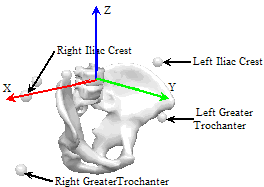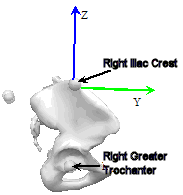Visual3D Pelvis
| Language: | English • français • italiano • português • español |
|---|
Note that the Visual3D pelvis does not generate landmarks at the Hip Joint Center automatically.
In the Visual 3D pelvis what part of the iliac crest is used as the landmark (i.e. do you just pick the point on the iliac crest that is at the midline -so inline with the greater trochanter, or is there something more particular that is palpated)? I am a little concerned about repeatability of marker placement on the crest since it is a larger bony protuberance and several spots could be selected?
The greater trochanter can be located quite reliably. As you point out, however, there isn't an identifiable landmark on the iliac crest. The Iliac Crest landmark should be placed consistently with a clinical measure of pelvic tilt. For example, if the pelvic tilt during the physical examination is considered to be zero degrees. The Iliac Crest marker is placed directly superior to the greater trochanter marker. This is a bit of a reliance on common sense, but it is always important that the results of your motion analysis are consistent with your clinical measures.

